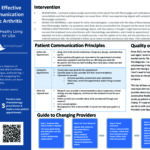PHILADELPHIA—“At age 12, I was diagnosed with psoriasis (PsO), followed by a diagnosis of psoriatic arthritis (PsA) at age 30,” said Ashley Krivohlavek of Oklahoma City in a poster presentation at ACR Convergence 2022. “I’m now 38.” Ms. Krivohlavek’s Story In 2020, I had been on an infused biologic for 18 months, but my…






